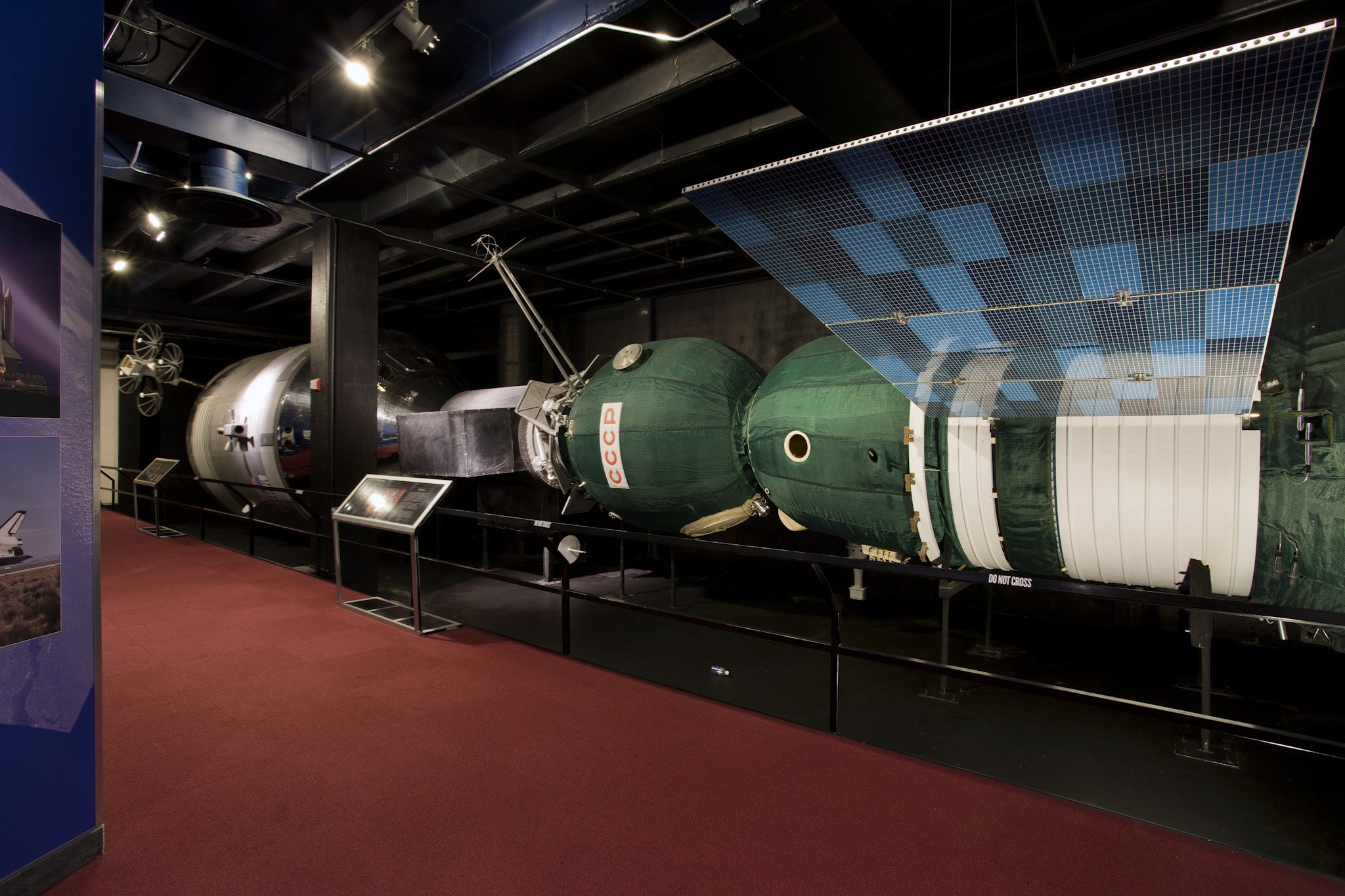
Apollo-Soyuz Test Project
Détente and the Thawing
of the Cold War
Soviet Soyuz spacecraft in orbit as seen from American Apollo spacecraft during the Apollo-Soyuz Test Project on July 17, 1975. Image credit: NASA
May 24, 1972. President Richard Nixon and Premier Aleksei Kosygin signing the agreement of cooperation in the exploration and use of outer space. Image credit: The White House
The Soviet Union also began to slowly open up about their space program to the public in general. For example, journalists were allowed to write articles that identified the space scientists by name. And, in March 1972, an American journalist from The New York Times was allowed into the Cosmonaut Training Center.
In May 1972, U.S. President Richard Nixon and Soviet Premier Aleksei N. Kosygin signed the Agreement Concerning Cooperation in the Exploration of the use of Outer Space for the Peaceful Purposes, thus creating an official agreement for cooperation in space.
ASTP Cooperation in Space agreement, signed by President Richard Nixon. Image credit: NASA
“We were a little of a spark or a foot in the door that started better communications.“
— Astronaut Vance Brand, ASTP astronaut
The End of an Era
The first Russian space station, Salyut-1, 1971.
Both sides had much to gain from a joint space mission. The United States was winding down its Apollo program and gearing up for its first space station, Skylab. NASA knew that there would be a gap between Skylab and the new space shuttle. During that gap between major initiatives, ASTP would bring some real time experience for its engineers. The US also could learn from the Soviets who had already ventured into their own space station program by launching the first space station, Salyut, in 1971.
The Soviets saw ASTP as a way to regain their space reputation, which had been on the decline since the Moon landing. They wanted to prove that their space technology was still comparable to the United States.
“…When you deal with people that are in the same line of work as you are, and you're around them for a short time, why, you discover that, well, they're human beings."”
— Astronaut Vance Brand, ASTP astronaut
U.S. and U.S.S.R. Cooperation
Russian and American Apollo-Soyuz Test Project (ASTP) - Prime Crew Portrait, February 27, 1975. From left: American astronauts "Deke" Slayton, Tom Stafford, Vance Brand, Russian cosmonauts Aleksei Leonov, Valeri Kubasov. Image credit: NASA
Apollo-Soyuz Test Project "Handshake in Space" between Astronaut Thomas Stafford and Cosmonaut Aleksei Leonov on July 17, 1975. Image credit: NASA
Apollo-Soyuz Test Project brought the two sides together, figuratively and literally. The crews consisted of Thomas Stafford, Vance Brand, and Deke Slayton on the American side and Aleksei Leonov and Valeri Kubasov on the Soviet side. On July 17, 1975, the two spacecraft docked using a docking module designed by the U.S. and U.S.S.R. and built by North American Rockwell. The Soyuz launch was the first Soviet launch to be televised live, it was watched by people in Russia, Europe and the US.
“It would be wrong to ask which country’s more beautiful. It would be right to say there is nothing more beautiful than our blue planet”
Upon docking, Stafford and Leonov met in the tunnel for a very famous handshake. For two days, the two crews performed experiments and exchanged gifts.
View from the Soyuz spacecraft of the Apollo Command Service Module with the docking adapter visible. Image credit: NASA
On July 19, 1975, the two spacecraft undocked and completed the rest of the mission separately. Both spacecraft made it safely back to Earth. The mission was considered a success from a technical and public relations standpoint. And, after the years of training and the culmination of the mission, the crew members from both sides considered each other friends.
“I really believe that we were sort of an example, the space program — an example to the countries.”
— Astronaut Vance Brand, ASTP astronaut
Setting the Stage for Future U.S./Russian Collaboration
ASTP Docking Module (in background) and Docking System (in foreground) at North American Rockwell facility, in Downey, California. Image credit: NASA
While ASTP did not eliminate all the issues between the U.S. and Russia, it did provide a platform for continued collaboration in space. It proved that the two sides could work together despite engineering and political barriers.
One huge engineering barrier was the docking of the two spacecraft. A docking mechanism had to be built to join the spacecraft together and also to serve as a type of airlock due to the difference in cabin pressure and oxygen mixtures in each spacecraft. Designed jointly and built by North American Rockwell, the Docking Module launched with the Apollo crew on July 15, 1975. Two days later, the crews successfully docked for the first joint mission between two historic rivals. Similar versions of this docking module were used later in the Shuttle/MIR program and the International Space Station.






